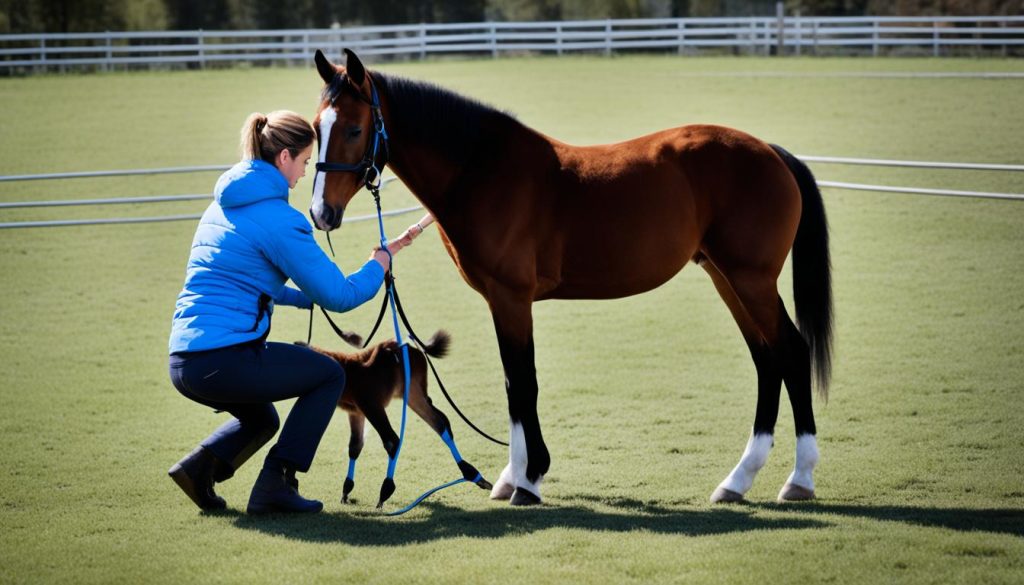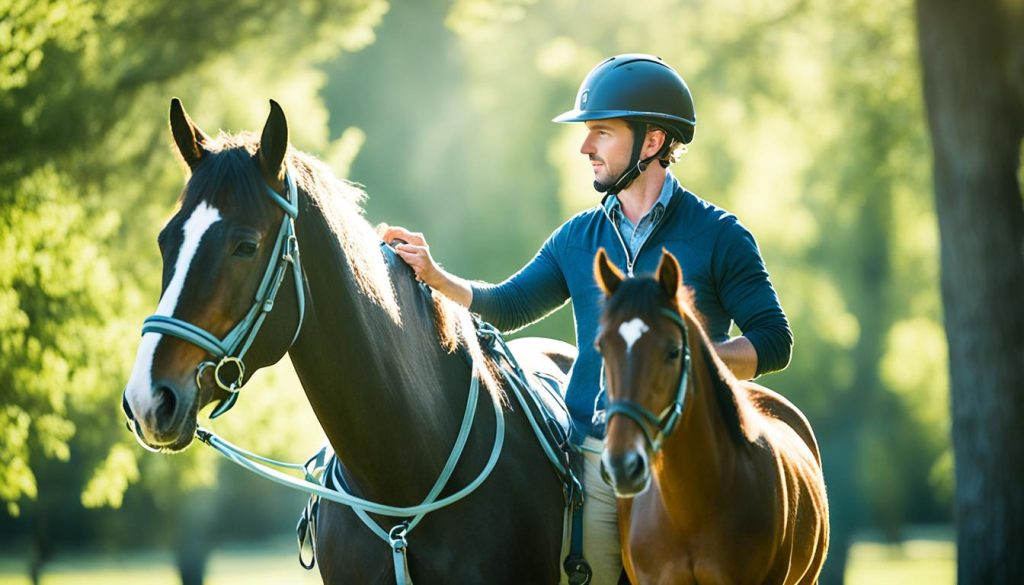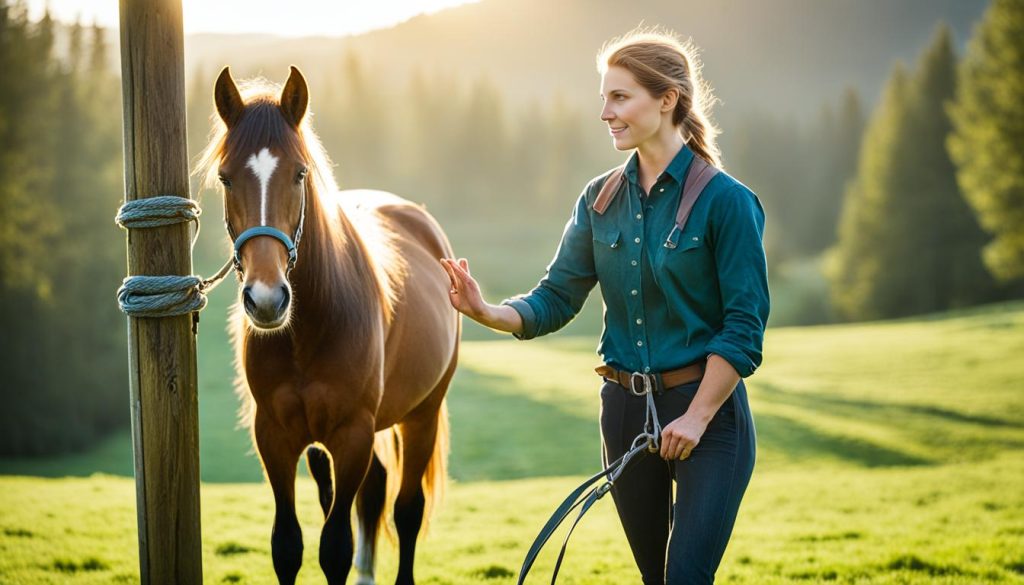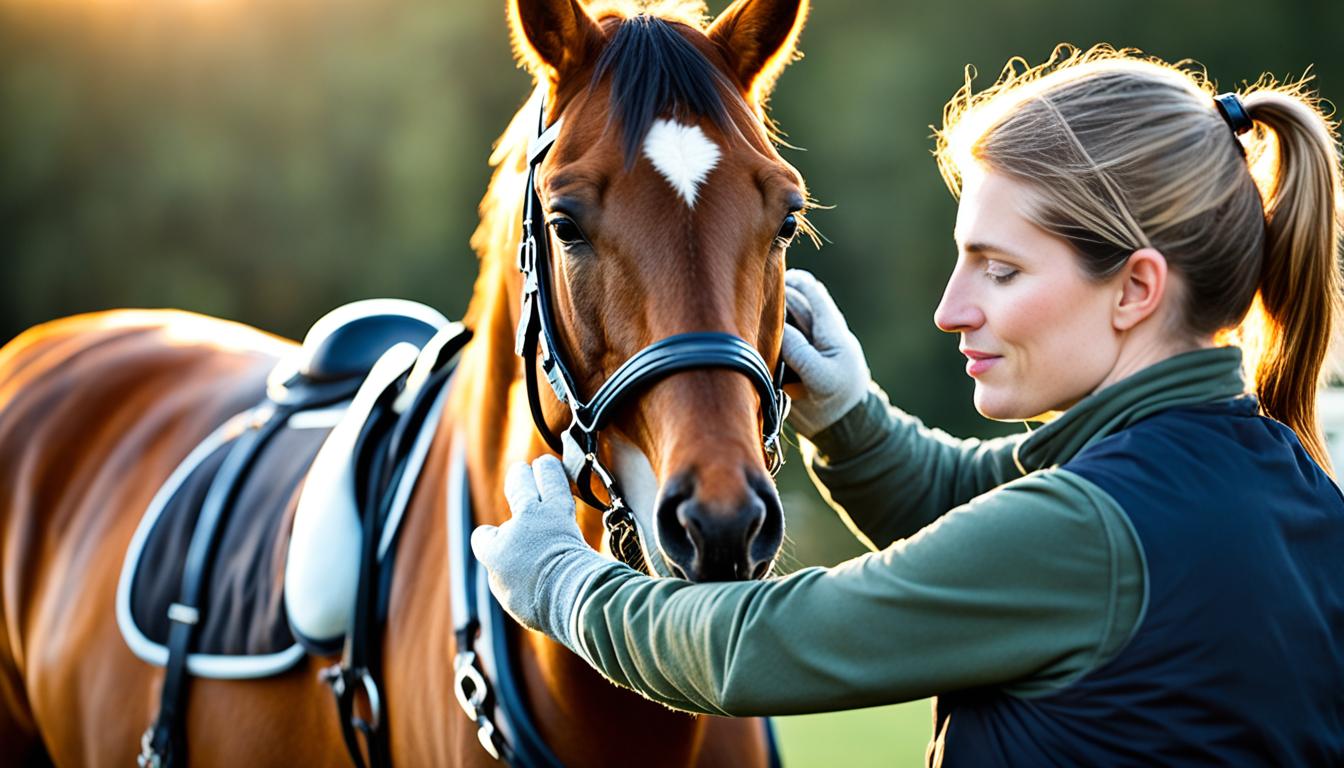Did you know that proper foal and young horse training is crucial for developing a strong, trusting partnership with your equine companion? It sets the foundation for a lifetime of success and ultimately determines the health and well-being of your horse.
Training a foal or young horse may seem like a daunting task, but with the right techniques and guidance, it can be a rewarding experience for both you and your horse. Whether you’re a beginner or an experienced equestrian, it’s important to approach training with expertise and follow proper guidelines to ensure the safety and comfort of your young horse.
In this article, we will explore essential foal and young horse training techniques, horse care tips, and equestrian training methods. By following expert advice and incorporating these techniques into your training program, you’ll be able to foster a positive relationship with your young horse and set a solid foundation for their future development.
Key Takeaways:
- Foal and young horse training is crucial for building a strong partnership with your equine companion.
- Approach training with expertise and follow proper guidelines to ensure your horse’s safety and comfort.
- Focus on techniques such as body control, desensitizing, halter training, leading, and basic care tasks.
- Gradual and consistent training is key to developing a well-trained and confident young horse.
- By investing time and effort into foal and young horse training, you’re setting the foundation for a lifetime of success.
Training the Foal: Building Body Control and Desensitizing
The first days of training foal training should focus on building body control and desensitizing techniques. This includes exercises to establish trust, teach the foal to lead, and introduce them to new sights, sounds, and stimuli. It is important to use gentle and patient techniques to ensure the foal’s confidence and willingness to learn. Gradually increasing the level of difficulty and exposure will help the foal develop body awareness and become more resilient to external stimuli.
When starting the *training journey* with your foal, it is necessary to prioritize two essential components: body control and desensitizing techniques. These early training sessions will lay the foundation for future success in the horse’s development and overall responsiveness. By focusing on these aspects, you’ll be working towards establishing a strong bond with your foal, building trust, and preparing them for a lifetime of learning and growth.
To begin, it’s crucial to understand the significance of body control in a foal’s training. This entails teaching the foal to understand and respond to your cues, enabling effective communication between you and your equine partner. Gentle techniques and positive reinforcement should be employed to ensure the foal feels secure and receptive to learning.
Remember, patience is paramount. Start with simple exercises, such as leading the foal in a controlled manner and teaching them to respond to your body language. As they become more comfortable and responsive, gradually increase the level of difficulty by introducing new challenges and focusing on refining their movements and coordination.

In addition to body control, desensitizing techniques play a crucial role in a foal’s training. These techniques allow the foal to become familiar with various sights, sounds, and stimuli that they may encounter throughout their life. By desensitizing the foal to these stimuli early on, you can greatly reduce the likelihood of fear or spooking behaviors in the future.
Introduce the foal to new objects, sounds, and environments gradually, ensuring they feel safe and supported throughout the process. Start with simple, non-threatening items and gradually progress to more challenging stimuli. By doing so, you are enabling the foal to develop their desensitization skills, allowing them to remain calm and composed in the face of unexpected or unfamiliar situations.
Body control and desensitizing techniques are fundamental aspects of foal training. By focusing on these areas, you are setting the stage for a successful training journey with your young horse. Remember, patience, consistency, and positivity are key when working with foals, ensuring a solid foundation for their future development. Stick to these principles, and you’ll find yourself building a trusting and harmonious partnership with your equine companion.
Halter Training and Leading the Foal
When it comes to training your foal, halter training and leading exercises are essential for teaching them to respect and respond to cues. By introducing the foal to wearing a halter gradually, using positive reinforcement and rewards, you can create a positive association with this important training tool.
Once the foal is comfortable with the halter, it’s time to introduce leading exercises. These exercises focus on teaching the foal to follow and respond to gentle cues, preparing them for future handling and training. Start with short sessions and gradually increase the duration and complexity of the exercises, ensuring the foal’s comfort and understanding.
The key to successful halter training and leading is consistency and patience. Remember, foals are young and still learning, so it’s important to be patient and give them time to process and understand the training exercises. Your calm and gentle approach will go a long way in building trust and cooperation with your foal.
Here are some guidelines to follow when halter training and leading your foal:
- Introduce the foal to the halter in a safe and quiet environment.
- Use positive reinforcement such as treats or praise to reward good behavior.
- Start with short leading exercises in a small, enclosed area.
- Gradually increase the length of the lead and introduce different environments.
- Teach the foal to respond to cues such as stopping, turning, and backing up.
- Be consistent with your cues and expectations.
- Monitor the foal’s behavior and adjust your training approach accordingly.
Remember, every foal is different, and they may progress at their own pace. It’s important to tailor your training to suit the individual needs of your foal. The goal is to build a solid foundation of trust, respect, and cooperation.

By following these halter training and leading exercises, you can create a strong bond with your foal and lay the groundwork for future training and handling. Remember to always prioritize the safety and comfort of your foal throughout the training process.
Foal Care Tasks: Bathing and Feet Handling
Foal care encompasses various tasks that contribute to their overall well-being and grooming. Among these tasks, bathing and handling the foal’s feet are crucial for their hygiene and health. By incorporating gentle and patient techniques, you can ensure that these activities become positive experiences for both the foal and you.
Bathing the Foal
Bathing is an essential part of foal care, as it helps maintain their cleanliness and hygiene. Introducing the foal to bathing gradually is key to making them comfortable with water and the bathing process. Begin with sponge baths, using a soft sponge to gently wet and cleanse the foal’s body. Over time, you can progress to a full shower, allowing the foal to become accustomed to the sensation of water running over their coat.
It’s important to remember that foals may initially be hesitant or even afraid of water. Use positive reinforcement to create a positive association with bathing. Offer encouraging words and rewards, such as treats or praise, to reinforce the foal’s calm behavior during bathing sessions. By gradually increasing the foal’s exposure to water and providing positive reinforcement, you can help them develop a positive attitude towards bathing.
Handling the Foal’s Feet
Properly handling the foal’s feet is essential for their future hoof care and grooming. Start by desensitizing the foal to having their feet touched. Gradually introduce the concept of lifting their feet on command, using a gentle and patient approach. Beginning with short sessions, gently lift each hoof and hold it for a brief moment, gradually extending the duration as the foal becomes more comfortable.
Positive reinforcement is crucial during foot-handling sessions. Reward the foal for their cooperation and calm behavior with treats, praise, or a gentle pat. It’s important to be consistent and patient during these training sessions, allowing the foal to build trust and confidence in having their feet handled.
Grooming the Foal
Grooming plays a vital role in maintaining the foal’s coat cleanliness and overall health. Regular grooming sessions help remove dirt, debris, and loose hair, promoting a healthy coat and skin. Use a soft brush or grooming mitt to gently brush the foal’s coat in the direction of hair growth.
During grooming sessions, take the opportunity to inspect the foal’s body for any signs of injury or skin issues. Pay attention to areas such as the mane, tail, and underbelly, as these areas are prone to tangles and dirt accumulation. Use gentle detangling techniques for any knots or tangles, taking care not to pull or cause discomfort to the foal.
A well-groomed foal not only looks clean and presentable but also improves their overall comfort and well-being. Regular grooming sessions also provide an opportunity for bonding and socialization between you and the foal.
By incorporating bathing, feet handling, and grooming into your foal care routine, you ensure their hygiene, comfort, and overall well-being. Remember to use gentle techniques and positive reinforcement, allowing the foal to develop trust and confidence in these essential tasks.
Young Horse Development: Stand Tied and Come to You
As your foal grows, it’s important to progress their training to more advanced exercises that will prepare them for various situations. Two crucial skills to develop during young horse development are standing tied and coming when called.
Standing Tied: A Skill for Everyday Handling
Teaching your young horse to stand tied is essential for vet visits, grooming sessions, and general handling. It helps them learn patience and self-control while ensuring their safety in different situations. To introduce the concept of standing tied, start by tying your young horse for short periods, gradually increasing the duration over time. Make sure to use a strong and secure tie, such as a quick-release knot, and always supervise your horse during this training process. Providing rewards, such as treats or praise, when they stand calmly will reinforce the desired behavior.
Coming When Called: A Useful Skill for Management
Teaching your young horse to come when called is beneficial for everyday handling and management. It allows you to easily catch your horse in the field or pasture, saving time and effort. Start by using a verbal cue, such as their name followed by a command like “come” or “here.” Use a positive and enthusiastic tone to encourage your young horse to respond. Reward them with treats or praise when they come to you, reinforcing the desired behavior. Consistency is key when teaching this skill, so practice regularly and create positive associations with responding to your call.
By incorporating these training exercises into your young horse’s development, you are setting a solid foundation for their future training and handling. Standing tied and coming when called not only improve their responsiveness and cooperation but also enhance their overall safety, making them more reliable and easier to handle in various situations.

“Training your young horse to stand tied and come when called builds essential skills for their safety, handling, and everyday management.”
Conclusion
Successfully training a foal or young horse is a crucial step in establishing a strong bond and partnership with your equine companion. By implementing expert-recommended horse training methods and foal training programs, you can create a solid foundation for future training endeavors.
Gradual and consistent training is key when working with young horses. Focusing on areas such as body control, desensitizing, halter training, leading, and care tasks ensures their safety, comfort, and overall development. Patience and dedication are vital throughout this process.
Remember, the goal is to raise a well-trained and confident young horse, and achieving this requires a combination of effective training techniques and a strong commitment to their growth and well-being. With the right approach, you can nurture a rewarding partnership that will undoubtedly bring you years of joy and success.
